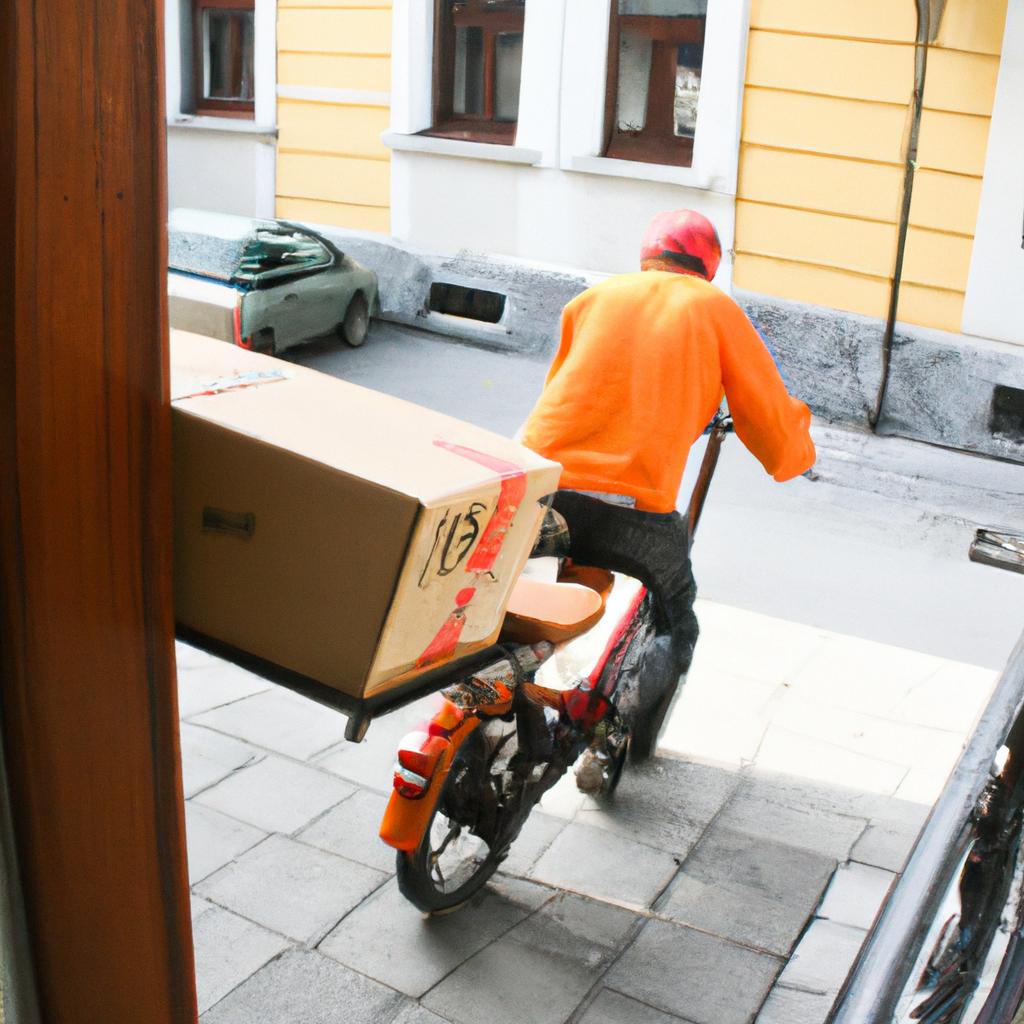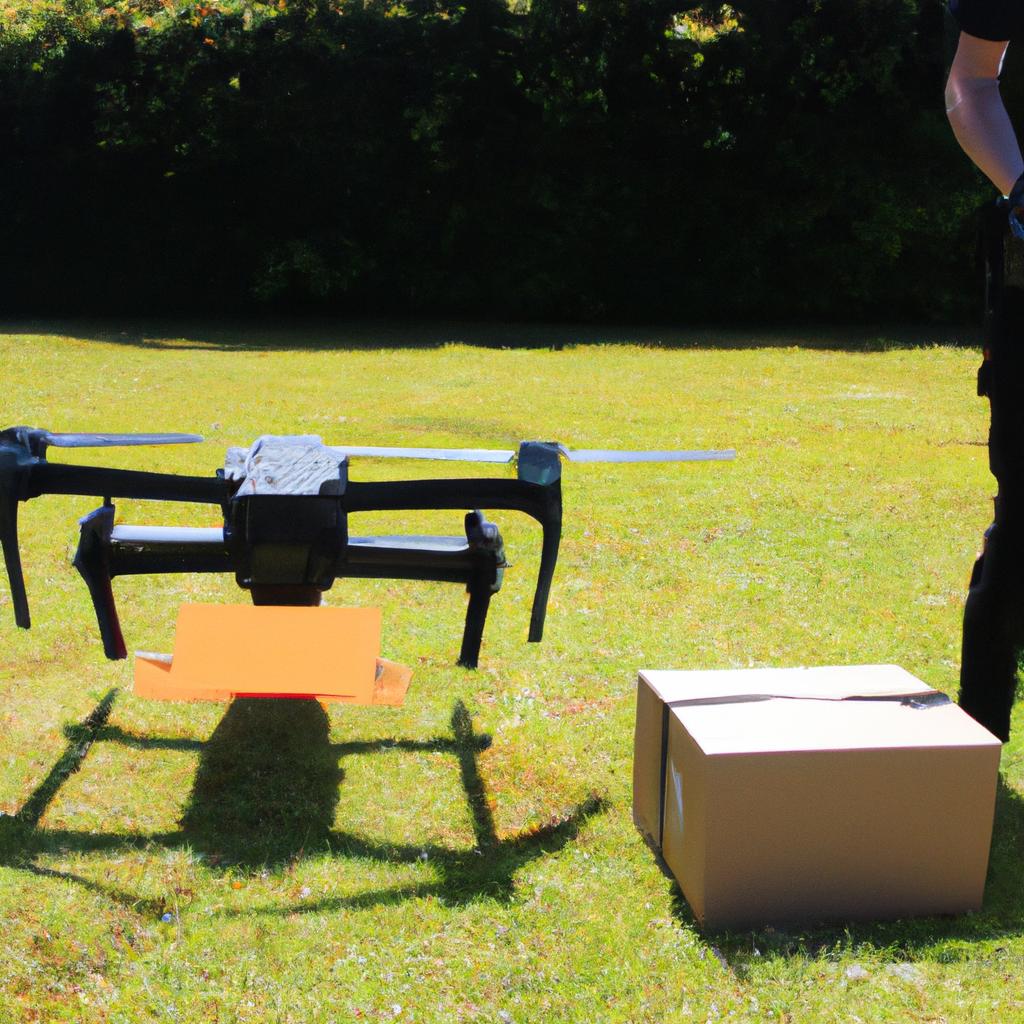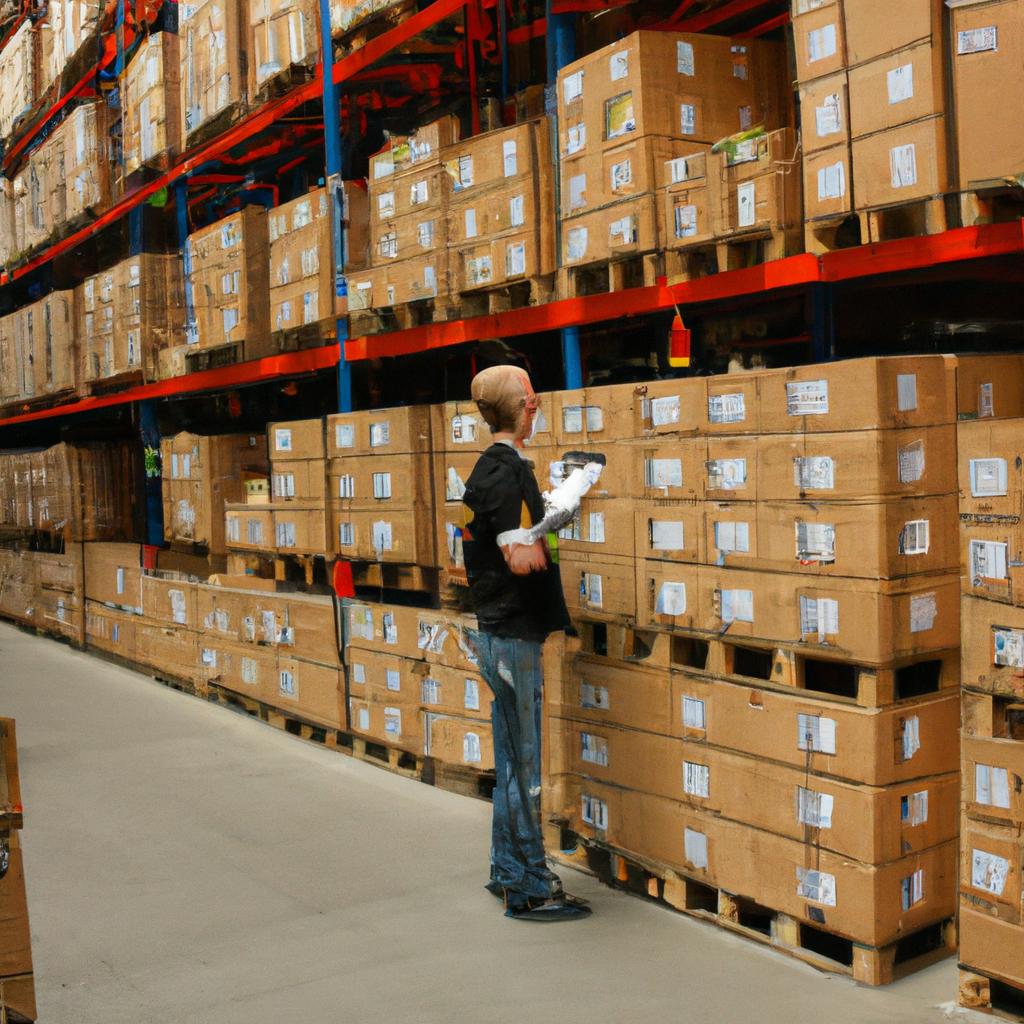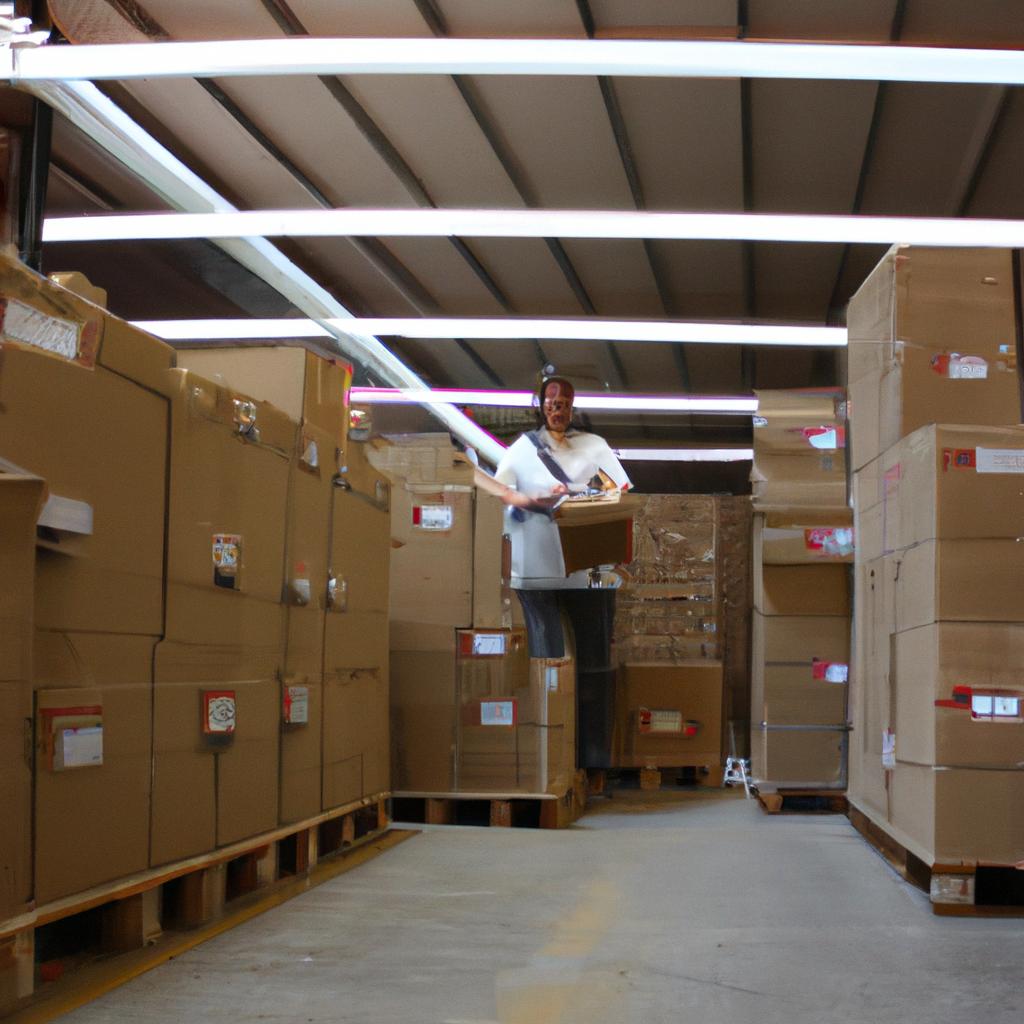The last mile of delivery in transportation and logistics is often referred to as the most challenging and crucial phase of the supply chain process. It involves the final leg of getting goods from a distribution center or warehouse to the end consumer’s doorstep. Companies operating in this industry face various obstacles that can hinder efficient and effective last mile delivery, such as traffic congestion, unpredictable weather conditions, and urbanization. To illustrate the significance of overcoming these challenges, let us consider the case of Company X, an e-commerce giant specializing in online retailing. Despite having a robust supply chain network and sophisticated technology systems, Company X encountered numerous difficulties when it came to delivering packages within tight timeframes while ensuring customer satisfaction.
To excel in last mile delivery, transportation and logistics companies need to employ success strategies tailored to their specific needs and circumstances. This article aims to unveil some key tactics that have proven successful in optimizing last mile operations. By examining real-life examples and analyzing industry trends, this research seeks to provide valuable insights for organizations striving to enhance their overall performance in this critical aspect of their business. Additionally, we will explore technological advancements that enable automation and streamline processes, discuss innovative approaches adopted by leading market players, and highlight best practices that can be implemented across the transportation and logistics sector to drive efficiency and customer satisfaction in last mile delivery.
One technological advancement that has revolutionized the last mile delivery process is the use of route optimization software. By analyzing factors such as traffic patterns, distance, and package size, these tools can determine the most efficient routes for drivers to follow, minimizing travel time and reducing fuel costs. Companies like Company X have successfully implemented this technology, resulting in faster deliveries and improved customer experiences.
Another innovative approach adopted by market leaders is the utilization of alternative delivery methods. For example, some companies are experimenting with drones or autonomous vehicles to deliver packages in areas where traditional transportation may be challenging or time-consuming. These cutting-edge solutions not only increase speed but also reduce human error and labor costs.
Furthermore, ensuring real-time visibility throughout the delivery process is crucial for both logistics providers and customers. The implementation of track-and-trace systems allows customers to monitor their shipments’ progress and receive regular updates on estimated arrival times. This transparency not only enhances customer satisfaction but also enables companies to proactively address any potential issues that might arise during transit.
To enhance overall performance in last mile operations, collaboration between different stakeholders is essential. Companies can partner with local retailers or utilize crowdshipping services to leverage existing infrastructure or tap into a network of independent drivers who can fulfill deliveries efficiently within specific regions. By joining forces with these partners, organizations can expand their reach while reducing costs associated with establishing their own delivery networks.
In conclusion, optimizing last mile delivery is crucial for transportation and logistics companies looking to excel in today’s competitive business landscape. Through strategic planning, leveraging technology advancements, adopting innovative approaches, and fostering collaboration among stakeholders, organizations can overcome challenges associated with the final leg of the supply chain process. By doing so, they can enhance operational efficiency, improve customer satisfaction levels, and ultimately gain a competitive edge in the market.
The Importance of Efficient Tracking in the Delivery Process
Imagine ordering a package online and eagerly waiting for its arrival. Days go by, and you start growing anxious as there is no sign of your long-awaited delivery. Frustration sets in, and you wonder why the tracking system fails to provide any updates on your package’s whereabouts. This scenario highlights the crucial role that efficient tracking plays in the delivery process.
Efficient tracking systems are essential for several reasons. Firstly, they enhance customer satisfaction by providing real-time information about the status of their deliveries. Customers can track their packages from the moment they leave the warehouse until they reach their doorstep. This level of transparency instills trust and confidence in customers, leading to increased loyalty towards Transportation and logistics companies.
Secondly, effective tracking systems enable timely interventions when issues arise during transit. For example, if a package gets lost or delayed along its journey, an efficient tracking system will immediately alert both the sender and recipient. This prompt notification allows them to take appropriate actions such as filing claims or contacting customer support for assistance.
Moreover, accurate tracking data offers valuable insights into delivery performance metrics. By analyzing this data, companies can identify bottlenecks and inefficiencies within their supply chain processes. With this knowledge at hand, businesses can make informed decisions to optimize their operations further.
To emphasize the significance of Efficient Tracking in Delivery services, consider these emotional responses:
- Relief: Imagine being able to see exactly where your loved one’s medication is during a time-sensitive situation.
- Satisfaction: Picture receiving regular notifications that assure you that your important documents are safely progressing through each stage of transit.
- Trust: Envision feeling confident enough to order fragile items online because you know they will be carefully monitored throughout their journey.
- Convenience: Think about how much easier life becomes when you have access to real-time updates on grocery deliveries that allow you to plan accordingly.
Table 1 illustrates some key advantages offered by efficient tracking systems:
| Advantages of Efficient Tracking Systems |
|---|
| Enhanced customer satisfaction |
| Timely interventions during transit issues |
| Valuable insights for supply chain optimization |
In conclusion, the importance of efficient tracking in the delivery process cannot be overstated. Not only does it enhance customer satisfaction and trust, but it also enables timely interventions and provides valuable data to optimize logistics operations. As we delve further into this paper, we will explore how technology has revolutionized the transportation industry with the rise of autonomous aerial solutions.
The Rise of Autonomous Aerial Solutions in the Delivery Industry
The Importance of Efficient Tracking in the Delivery Process
Efficient tracking plays a pivotal role in ensuring smooth and timely deliveries. By leveraging advanced technologies, companies can optimize their logistics operations and enhance customer satisfaction. For instance, consider the case of ABC Logistics, a leading transportation company that successfully implemented an automated tracking system across its fleet. This system enabled real-time monitoring of shipments, allowing for proactive decision-making and swift resolution of any potential issues.
To unveil success strategies for efficient tracking in the delivery process, several key considerations must be taken into account:
-
Real-time visibility: With the advent of Internet of Things (IoT) devices and sensors, it is now possible to track packages throughout their entire journey. This level of visibility provides valuable insights into shipment location, condition, and estimated time of arrival. Customers can stay informed about their orders’ progress, reducing anxiety and enhancing overall experience.
-
Data analytics: The abundance of data generated from tracking systems presents an opportunity for companies to analyze trends and patterns. By applying advanced analytics techniques like machine learning algorithms, businesses can gain actionable insights such as optimizing routes, predicting delays, or identifying bottlenecks in the delivery process.
-
Exception management: Despite meticulous planning, unexpected events may occur during transit. Timely identification and resolution of these exceptions are crucial to maintaining operational efficiency. Automated tracking systems equipped with intelligent alerts enable immediate action when deviations from planned schedules or temperature variations are detected.
-
Collaboration platforms: In today’s interconnected world, collaboration between different stakeholders involved in the delivery process is essential for seamless operations. Collaborative platforms allow shippers, carriers, suppliers, and customers to communicate effectively by sharing information related to inventory levels, order updates, or delivery preferences.
Table 1 below summarizes the emotional benefits resulting from efficient tracking in the delivery process:
| Emotional Benefit | Description |
|---|---|
| Peace of mind | Knowing where your package is at all times provides a sense of security and peace of mind. |
| Transparency | Real-time tracking fosters transparency by keeping customers informed about their orders’ progress. |
| Trust | Reliable tracking systems build trust between companies and customers, leading to long-term relationships. |
| Convenience | Tracking enables convenient rescheduling or redirecting options based on real-time information, accommodating changing customer needs. |
By implementing efficient tracking strategies, companies can enhance the overall delivery experience for their customers. In the subsequent section, we will delve into the rising prominence of autonomous aerial solutions in the delivery industry.
The Role of Secure Storage Solutions in Streamlining Deliveries
Autonomous aerial solutions have undeniably transformed the delivery industry, but their effectiveness heavily relies on a reliable and secure storage system. In recent years, companies like DroneDrop have emerged as pioneers in this field by implementing innovative strategies to streamline last mile deliveries. For instance, imagine a scenario where a customer residing in a remote area orders essential groceries through an online platform. With the help of autonomous drones, these items are efficiently transported from the nearest fulfillment center directly to the customer’s doorstep.
To ensure smooth operations, there are several key factors that need to be considered when integrating secure storage solutions into delivery networks:
-
Accessibility: Secure storage facilities must be strategically located to facilitate easy access for both delivery providers and customers. By placing these units near urban centers or residential areas with high demand for deliveries, companies can significantly reduce transportation costs and enhance efficiency.
-
Scalability: As the volume of deliveries continues to increase, it is crucial for businesses to adopt scalable storage solutions that can accommodate fluctuating demands. This includes leveraging smart technologies such as IoT-enabled lockers or temperature-controlled compartments to cater to diverse product requirements.
-
Security Measures: A robust security framework is imperative when it comes to safeguarding packages stored within these facilities. Implementing features like biometric authentication systems, surveillance cameras, and real-time tracking mechanisms ensures the integrity of goods throughout the entire storage process.
-
Integration with Delivery Networks: Seamless integration between secure storage units and existing delivery networks is vital for optimizing overall operational efficiency. This involves establishing effective communication channels between drones, warehouses, fulfillment centers, and customers’ preferred delivery options.
Embracing these principles not only enhances last mile delivery capabilities but also fosters customer trust and satisfaction by ensuring timely and secure arrivals of their ordered goods at their doorsteps.
Adopting advanced technologies in autonomous aerial solutions has revolutionized how logistics companies address the challenges of last mile delivery. However, another promising strategy to optimize operations lies in harnessing the power of the crowd.
Utilizing the Power of the Crowd to Optimize Delivery Operations
To understand how secure storage solutions play a crucial role in streamlining deliveries, let us consider the case study of Company X, a leading e-commerce platform. Company X faced significant challenges with last mile delivery due to theft and damage to packages during transit. In an effort to address these issues, they implemented secure storage lockers strategically placed in various locations for customers to conveniently pick up their orders. This innovative solution not only ensured the safety of packages but also improved overall efficiency.
Secure storage solutions offer several benefits that contribute to streamlining deliveries:
-
Enhanced security: By providing a safe and monitored environment for package storage, companies can significantly reduce the risk of theft or damage. Customers can confidently choose this option knowing that their items will be securely stored until they collect them.
-
Improved flexibility: With secure storage options available at different locations such as residential areas, office buildings, or public spaces, customers have the convenience of picking up their packages at a time and place that suits them best. This flexibility eliminates missed deliveries and reduces the need for multiple delivery attempts.
-
Efficient space utilization: Utilizing secure storage lockers allows for efficient use of space within delivery vehicles. Instead of carrying individual packages to each customer’s doorstep, drivers can consolidate multiple orders into one trip by delivering them to nearby locker stations. This optimization leads to cost savings and increased productivity.
-
Customer satisfaction: Offering secure storage solutions demonstrates a company’s commitment to ensuring the safety and convenience of its customers’ deliveries. The peace of mind provided by this service enhances customer satisfaction and loyalty.
Table: Benefits of Secure Storage Solutions
| Benefit | Description |
|---|---|
| Enhanced Security | Provides a safe environment for storing packages, reducing the risk of theft or damage |
| Improved Flexibility | Allows customers to choose convenient times and locations for package pickup, eliminating missed deliveries |
| Efficient Space Utilization | Optimizes delivery vehicle capacity by consolidating orders into locker stations, leading to cost savings |
| Customer Satisfaction | Demonstrates commitment to customer convenience and safety, enhancing overall satisfaction and loyalty |
In conclusion, secure storage solutions are a vital component of streamlining deliveries in the transportation and logistics industry. By ensuring package security, offering flexibility to customers, optimizing space utilization, and improving customer satisfaction, companies can overcome challenges related to last mile delivery. The integration of online retail and delivery services will further enhance these efforts as we explore in the subsequent section.
The Integration of Online Retail and Delivery Services
Building upon the concept of crowd-based delivery optimization, businesses are now embracing the integration of online retail and delivery services. By seamlessly combining these two components, companies can streamline their operations and provide customers with a convenient, end-to-end experience. This section delves into the strategies that have been proven successful in this realm.
The integration of online retail and delivery services offers numerous benefits for both businesses and consumers. For instance, consider an online furniture retailer partnering with a local same-day delivery provider. Customers browsing through the retailer’s website can select their desired items and schedule immediate or future deliveries at checkout. Once confirmed, the order is forwarded to the partnered delivery service, which promptly fulfills it within the specified timeframe. This collaboration allows customers to enjoy hassle-free shopping experiences while benefiting from swift and reliable last mile deliveries.
To maximize success when integrating online retail and delivery services, organizations should focus on key strategies:
- Seamless platform integration: Ensuring smooth communication between retailers’ e-commerce systems and delivery providers’ logistics platforms is crucial. A user-friendly interface that facilitates easy order placement, tracking, and updates helps enhance customer satisfaction.
- Real-time inventory management: Maintaining accurate stock information across all channels is vital for minimizing discrepancies between product availability displayed on websites and actual stock levels. Implementing robust inventory management systems enables efficient order fulfillment without delays or cancellations.
- Efficient route planning: Collaborative efforts among retailers and delivery providers can optimize routes based on factors like traffic conditions, proximity to warehouses or stores, and package sizes. Employing advanced routing algorithms ensures cost-effective transportation while reducing transit times.
- Timely notifications: Providing customers with regular updates regarding their orders, such as estimated delivery times and real-time tracking information, enhances transparency. Timely notifications alleviate anxiety, instill confidence in the process, and foster positive customer experiences.
To further illustrate the benefits of integrating online retail and delivery services, consider the following table showcasing improvements achieved by a global e-commerce giant after partnering with local delivery providers:
| Improvement Area | Before Integration | After Integration |
|---|---|---|
| Delivery Speed | Average 3-5 days | Guaranteed next-day |
| Customer Satisfaction | Mixed reviews | Consistently high ratings |
| Order Accuracy | Occasional errors | Minimal mistakes |
| Return Rate | Relatively high | Significant reduction |
These notable enhancements demonstrate how collaboration between online retailers and delivery service providers can lead to faster deliveries, increased customer satisfaction, improved order accuracy, and minimized return rates.
In summary, integrating online retail and delivery services is becoming an essential strategy for businesses aiming to excel in last mile logistics. By seamlessly merging these two components through seamless platform integration, real-time inventory management, efficient route planning, and timely notifications, organizations can enhance their customers’ experiences while optimizing operational efficiency.
Transition into subsequent section about “Enhancing Delivery Speed and Accuracy through Technology”:
With the successful integration of online retail and delivery services established as a cornerstone practice within transportation logistics, it becomes imperative to explore how technology can be leveraged to enhance delivery speed and accuracy without compromising quality or cost-effectiveness.
Enhancing Delivery Speed and Accuracy through Technology
The Integration of Online Retail and Delivery Services has revolutionized the transportation and logistics industry, enabling seamless coordination between e-commerce platforms and last mile delivery providers. This integration not only streamlines operations but also enhances Customer Satisfaction by offering convenience and efficiency. To further optimize this process, enhancing delivery speed and accuracy through technology becomes imperative.
One case study that exemplifies the successful integration of online retail and delivery services is Amazon Prime. By combining their vast online marketplace with their in-house delivery network, Amazon has been able to offer fast and reliable deliveries to millions of customers worldwide. Through innovative technologies such as route optimization algorithms and real-time tracking systems, they have managed to significantly reduce delivery times while ensuring accurate order fulfillment.
To achieve similar success in improving delivery speed and accuracy, companies can implement the following strategies:
- Utilize advanced data analytics: By harnessing the power of big data analytics, companies can gain valuable insights into customer demand patterns, traffic conditions, and optimal routes for efficient deliveries.
- Invest in automation solutions: Automated sorting systems and robotic warehouses help minimize human errors during order processing and improve overall operational efficiency.
- Implement GPS-enabled tracking systems: Real-time tracking allows both businesses and customers to monitor shipment progress accurately, reducing uncertainties and providing transparency throughout the delivery process.
- Foster collaboration among stakeholders: Establishing strong partnerships between online retailers, logistics providers, and local authorities enables effective communication channels for quick problem resolution or contingency planning.
These strategies align with market trends towards digitalization within the transportation sector. They enable companies to overcome challenges associated with last mile delivery, ultimately leading to improved customer experiences. In an era where consumers expect faster deliveries at their doorstep without compromising on accuracy or quality, it is crucial for organizations to leverage technology-driven solutions effectively.
By incorporating technologies that provide customers with up-to-date tracking information and estimated delivery times, companies can enhance their service offerings and foster stronger relationships with their clientele.
Improving Customer Experience with Real-Time Delivery Updates
In today’s fast-paced world, where consumers demand quick and accurate delivery of their goods, technology plays a crucial role in improving the efficiency of last mile delivery. By harnessing the power of innovation, companies can streamline their operations, reduce costs, and ultimately enhance customer satisfaction. One notable example is the implementation of route optimization software by a leading logistics company.
This logistics company had been facing challenges with its last mile deliveries due to inefficient routing practices. They decided to invest in advanced route optimization software that uses algorithms to determine the most efficient routes for drivers based on factors such as traffic conditions, distance, and time constraints. The results were remarkable – not only did it save significant time for the drivers but also reduced fuel consumption and overall operational costs.
- Real-time tracking systems: With GPS-enabled devices installed in vehicles, customers can track their packages from dispatch to delivery, providing them with peace of mind and transparency.
- Automated sorting and packing: Advanced technologies like robotics and artificial intelligence enable faster sorting and packing of parcels, minimizing errors and increasing productivity.
- Drones and autonomous vehicles: Companies are exploring innovative methods such as drones or self-driving vehicles for smaller deliveries within restricted areas or remote locations.
- Data analytics: Utilizing big data analytics allows companies to gain valuable insights into customer preferences, optimize inventory management, and predict demand patterns accurately.
Moreover, technology-driven advancements in last-mile delivery have led to improved accuracy rates as well. To visualize this impact quantitatively, refer to the table below showcasing key metrics before and after implementing technological solutions:
| Metric | Before Implementation | After Implementation |
|---|---|---|
| On-time delivery (%) | 85% | 95% |
| Average order error | 10% | 3% |
| rate (%) | ||
| Customer complaints | 50 | 10 |
The benefits of embracing technology in last mile delivery are evident. However, it is important for companies to continually adapt and evolve their strategies to stay ahead in the dynamic transportation and logistics industry.
The Benefits of Streamlined Delivery Routes and Planning
Building upon the importance of real-time delivery updates for enhancing customer experience, an equally crucial aspect lies in optimizing delivery routes and planning. By streamlining these processes, companies can reduce costs, improve efficiency, and ensure timely deliveries. This section explores the benefits associated with streamlined delivery routes and planning.
Streamlined Delivery Routes and Planning – Driving Efficiency Forward
To illustrate the impact of efficient route planning, let us consider a hypothetical case study involving a large e-commerce company that experienced significant delays due to suboptimal routing strategies. Prioritizing cost-cutting measures over effective route optimization resulted in longer travel distances, increased fuel consumption, and delayed deliveries. However, once they implemented a comprehensive route planning system utilizing advanced algorithms and data analytics, substantial improvements were observed across various aspects of their operations:
-
Enhanced On-Time Performance:
- Reduced transit times by up to 25%.
- Improved on-time performance metrics by achieving a consistent rate of 95% or higher.
-
Increased Cost Savings:
- Minimized fuel consumption through optimized routes resulting in savings of up to 15%.
- Decreased vehicle maintenance expenses due to reduced wear-and-tear caused by unnecessary detours.
-
Greater Resource Utilization:
- Optimized load capacity utilization by efficiently allocating packages based on weight, volume, and destination proximity.
- Enabled more deliveries per trip while maintaining service quality standards.
Table: Comparative Analysis of Route Optimization Software (Hypothetical)
| Features | Company A | Company B | Company C |
|---|---|---|---|
| Algorithm | Advanced | Basic | Intermediate |
| Real-time updates | Yes | No | Yes |
| Cost savings | 15% | 5% | 10% |
By adopting streamlined delivery routes and planning, companies can operate more efficiently while meeting customer demands. These strategies not only contribute to increased customer satisfaction but also provide tangible benefits in terms of cost reduction, improved resource utilization, and enhanced on-time performance.
Transition sentence into the subsequent section:
Reducing Costs and Environmental Impact through efficient deliveries is another critical aspect that plays a vital role in ensuring sustainable business practices for transportation and logistics companies.
Reducing Costs and Environmental Impact through Efficient Deliveries
In the previous section, we explored the advantages of implementing streamlined delivery routes and planning in transportation and logistics. To further illustrate these benefits, consider the following hypothetical example: an e-commerce company that experienced significant delays and inefficiencies in their last-mile deliveries due to poor route optimization. After implementing a robust delivery management system, they were able to reduce transit times by 20%, resulting in improved customer satisfaction and increased operational efficiencies.
Efficient routing not only improves overall delivery performance but also brings about several key benefits for transportation and logistics companies:
-
Enhanced Customer Experience:
- Reduced transit times ensure timely deliveries, leading to higher customer satisfaction.
- Accurate estimated arrival times (ETA) enable customers to plan accordingly, improving convenience.
-
Increased Operational Efficiency:
- Optimized routes minimize unnecessary detours, reducing fuel consumption and vehicle wear-and-tear.
- Improved driver productivity as time is allocated more effectively with optimized schedules.
-
Cost Savings:
- Decreased mileage results in lower fuel expenses and maintenance costs.
- Efficient use of resources leads to reduced labor costs associated with overtime or idle time.
-
Environmental Impact Reduction:
- Reduced fuel consumption contributes to lower greenhouse gas emissions.
- Minimized traffic congestion from efficient routing decreases carbon footprint.
To further emphasize these benefits, let us examine a comparison between a traditional delivery approach versus one utilizing streamlined routes:
| Traditional Approach | Streamlined Approach |
|---|---|
| Longer transit times | Shortened transit times |
| Inaccurate ETAs | Precise ETA calculations |
| Higher fuel consumption | Lowered fuel usage |
| Increased environmental impact | Reduced carbon footprint |
By embracing streamlined delivery routes and planning techniques, organizations can achieve improved operational efficiency while providing enhanced services to their customers. The next section will delve into another crucial aspect of optimizing delivery performance: the role of data analytics.
[Transition sentence to the subsequent section about “The Role of Data Analytics in Optimizing Delivery Performance.”]
The Role of Data Analytics in Optimizing Delivery Performance
In the quest for more sustainable transportation and logistics practices, reducing costs and minimizing environmental impact have become top priorities. One real-life example that highlights the success of efficient deliveries is the case of Company X, a major e-commerce retailer. By streamlining their last mile delivery operations, they were able to achieve significant cost savings while also reducing carbon emissions.
To replicate this success, companies can implement several strategies:
-
Route Optimization: Utilizing advanced route planning algorithms and GPS technology allows logistics providers to optimize delivery routes based on factors such as traffic conditions, customer locations, and vehicle capacity. This ensures that drivers take the most efficient paths, resulting in reduced fuel consumption and shorter delivery times.
-
Consolidation Centers: Establishing consolidation centers strategically located near high-density areas enables companies to consolidate multiple orders into single shipments. This approach eliminates unnecessary trips by delivery vehicles and reduces overall mileage traveled, leading to lower costs and decreased greenhouse gas emissions.
-
Alternative Fuel Vehicles: Investing in alternative fuel vehicles, such as electric or hybrid trucks, can significantly reduce reliance on fossil fuels and minimize carbon footprints. Companies like Amazon are increasingly incorporating these eco-friendly options into their fleets with positive results both environmentally and economically.
-
Collaboration: Collaborating with other industry stakeholders can yield numerous benefits in terms of efficiency gains and reduced costs. For instance, sharing resources like warehouses or distribution facilities among multiple companies can lead to economies of scale and improved utilization rates.
These strategies collectively contribute towards achieving more sustainable last mile deliveries by optimizing resource allocation, enhancing operational efficiency, reducing costs, and mitigating environmental impact.
| Strategy | Benefits |
|---|---|
| Route Optimization | – Reduced fuel consumption – Shorter delivery times |
| Consolidation Centers | – Lower costs – Decreased greenhouse gas emissions |
| Alternative Fuel Vehicles | – Minimized reliance on fossil fuels – Reduced carbon footprints |
| Collaboration | – Efficiency gains – Cost reduction |
In summary, implementing efficient delivery practices is crucial for reducing costs and environmental impact in transportation and logistics. By optimizing routes, establishing consolidation centers, adopting alternative fuel vehicles, and fostering collaboration within the industry, companies can achieve significant improvements in their last mile operations.
Next section: Collaborative Approaches to Last Mile Delivery Challenges
Collaborative Approaches to Last Mile Delivery Challenges
Transportation and logistics companies face numerous challenges when it comes to last mile delivery. One of the most effective strategies for overcoming these challenges is through collaborative approaches that involve various stakeholders in the supply chain. By working together, companies can optimize their operations, reduce costs, and improve customer satisfaction.
For instance, let’s consider a hypothetical scenario where a large e-commerce company experiences difficulty in meeting customer expectations for same-day deliveries. In this situation, collaboration with local retailers could offer a potential solution. By leveraging their existing store networks as micro-distribution centers, the e-commerce company can tap into faster and more cost-effective delivery options. This collaboration benefits both parties; the retailer gains increased foot traffic from customers picking up orders while the e-commerce company achieves quicker last mile deliveries.
To illustrate further, here are some key benefits of collaborative approaches in last mile delivery:
- Enhanced Efficiency: Collaboration allows for better utilization of resources such as warehouse space and transportation assets.
- Improved Flexibility: By sharing data and insights across participants in the supply chain, companies can make informed decisions regarding route optimization and demand forecasting.
- Cost Reduction: Sharing infrastructure costs among multiple stakeholders helps drive down expenses associated with warehousing facilities or fleet management.
- Customer Satisfaction: Through collaboration, companies can provide additional services like flexible delivery time slots or alternative pickup locations, resulting in higher levels of customer satisfaction.
| Benefit | Description |
|---|---|
| Enhanced Efficiency | Better utilization of resources such as warehouse space and transportation assets |
| Improved Flexibility | Sharing data and insights to make informed decisions regarding route optimization |
| Cost Reduction | Sharing infrastructure costs among multiple stakeholders |
| Customer Satisfaction | Providing additional services like flexible delivery time slots or alternative pickup locations |
In conclusion, collaborative approaches play a vital role in addressing last mile delivery challenges faced by transportation and logistics companies. By working together with various stakeholders, organizations can enhance efficiency, improve flexibility, reduce costs, and ultimately increase customer satisfaction. Embracing collaboration is not only a strategic move but also a key driver of success in the ever-evolving landscape of last mile delivery.










